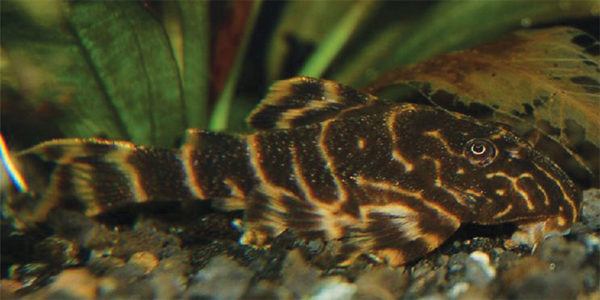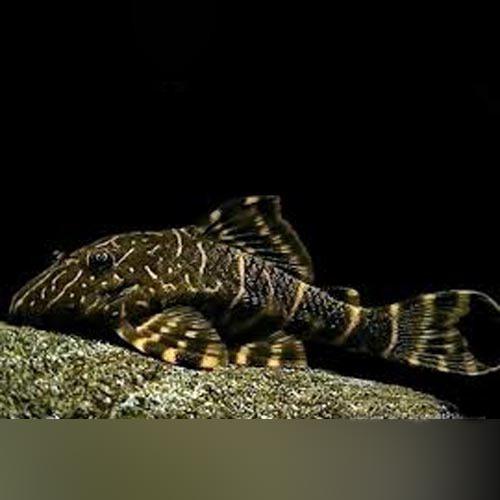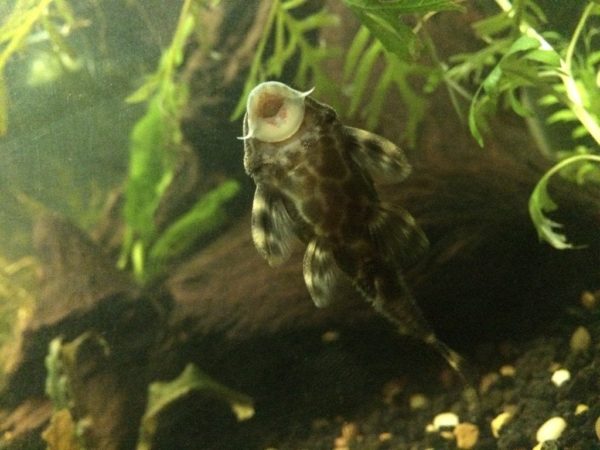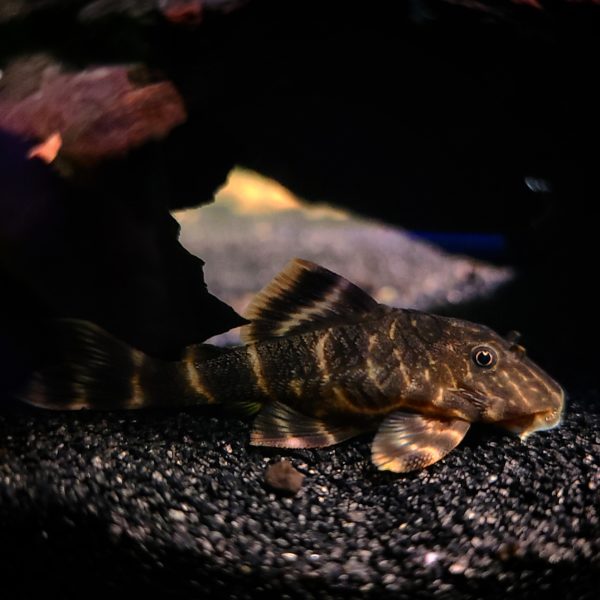Table of Contents
Clown Pleco: An Introduction
Clown plecos, also known as Panaque Maccus, are small, bottom-dwelling freshwater fish native to South America. They are named for their colorful patterns and are popular among aquarists for their peaceful nature and ability to eat algae.
Clown plecos require a well-established tank with plenty of hiding places and a diet consisting of vegetables and high-quality pleco pellets.
Clown Pleco Overview
Are you on the lookout for a freshwater fish that is easy to maintain and beautiful to start at? Well, you have come to the right place.
The Clown Pleco is an incredibly small fish kept in aquariums because of its beautiful appearance. The fish remains small even in size and like to stay in the bottom-most part of a given aquarium.
Scientifically known as Panaqolus Maccus has been kept by hobbyists for quite a long time now. In 1993, the fish gained formal recognition, although it had been in the retail market before its formal recognition.
The fish is originally from the South American region, specifically in Venezuela and Colombia. It is a generally peaceful fish and will share a tank with other fish varieties.
The reason why it is such a popular fish among beginner aquarists is because of the low maintenance. As long as you know how to manage the correct environmental settings and feed them the right food, keeping clown peckoltia isn’t as complicated.
More importantly, clown plecos are amazing to watch. Despite their small size and being the bottom-feeder fish, they are interactive and move around a lot.
If you are considering getting a clown pleco for your aquarium, this is your time. And, we have got your back with the care guide, enlisting all the information that you can think of.
| Information Chart | Clown Pleco |
| Scientific Name | Panaque maccus |
| Family | Armored catfish |
| Care level | Easy |
| Temperament | Peaceful and timid |
| Color | Mixture of brown, black, yellow, grey, and white stripes and patterns |
| Lifespan | 10-12 years |
| Size | Up to 3.5 inches |
| Diet | Omnivore |
| Minimum Tank Size | 10-20 gallons |
| Temperature | 73°F-82°F |
| Water Conditions | Tropical freshwater |
| Tank Mate Compatibility | Community fish breeds smaller in size |
Clown Pleco Appearance

It is a relatively small aquarium fish, with the mature fish reaching a maximum body size of 3.5 inches long. Most hobbyists who go for the Clown Pleco usually opt for it because of its stunning beauty. It has a body that is dark black that is encircled with bands that vary in color. Due to their small appearance and size, they are often termed as “dwarf pleco.”
It is interesting to note that these fishes exhibit different colors and are influenced by things to do with mood, diet, and age. The fish juveniles tend to have bright colors, and that will fade away when they mature.
The vibrancy of the colors and the bold-stroke patterns make them so distinguishable amidst all the other fishes that you keep in the aquarium. However, compared to the wild clown plecos, the ones in captivity have a lighter color.
Better yet, the majority of the plecos that are kept in captivity come with a big and thick head with a tapered body around the dorsal fins. The slimming of their body happens around the caudal peduncle. Also, their dorsal fins have a taller appearance and stand out from the rest of their appearance.
Although quite rare, the dorsal fins and the pectoral fins in the clown pleco measure the same in size, and they are stacked away in the back and lie around the substrate in the tank.
Clown Plecos that are kept in aquariums that are placed outdoors tend to exhibit deeper coloration than those kept indoors. Again it is very difficult to differentiate between the males and females of the fish species.
Experienced hobbyists can do this, and they usually distinguish the males from the females by looking at bristles on the head, suggesting that one is male. On average, though, both the sexes closely resemble each other making it cumbersome to distinguish them.
When distinguishing the large male pleco from the female ones, the aquarists generally look at their whiskers and the odontodes, which are longer in male fishes.
Types of Plecos
Besides the clown plecos, there are a few other types that you should know of.
Some of the types include:
- Bristlenose pleco
- Zebra pleco
- Gold Nugget pleco
- Sailfin pleco
- Royal pleco
- Snowball pleco
- Rubber lip pleco
- Leopard frog pleco
- Peppermint pleco
- Candy striped pleco
- Vampire pleco
- Sunshine pleco
- Blue eyed pleco
- Butterfly pleco
Lifespan of Clown Pleco
The best factor about owning an aquarium catfish or clown pleco is that they have a lifespan of 10-12 years. If you are someone who gets attached to pets very easily and likes to take care of them for extended periods, you will love adding a clown pleco to your aquarium.
However, since they are freshwater fishes, you need to be highly alert about the kind of living conditions you provide them with. Generally, these fishes aren’t very demanding in maintenance, so you don’t have to go out of your way to do things.
Maintain the water quality, feed them the correct diet and check for signs of stress, and you are all set to have a companion for over a decade.
Clown Pleco Size
Although we have briefly mentioned the size of a Clown Plecostomus in the Appearance section, let us walk you through a better outlook.
The typical size of a clown pleco fish is around 3 to 3.5 inches long. However, a few rare ones can even grow up to 4 inches in length, which is very rare. The size of the fish typically depends on the kind of care they are getting and their genetic predisposition.
Clown Pleco Natural Habitat and Origin
The fish is originally from Venezuela and Colombia where they were originally captured from. In the wild, the fish lives in the freshwater rivers of the Amazon and, therefore, will very much readily survive in captivity as long optimum conditions are set in the aquarium.
Clown plecos are generally used in the Venezuelan rivers where the water is soft and has a swift and persistent current and neutral pH. The heavy vegetation around those water bodies is also a reason why these small freshwater fishes are herbivores. They primarily originated in the Caroni and Apure river basins.
These rivers have an atypical vegetative condition with plant matter, rocks, sticks, and driftwood due to the nearby forested region. Despite being in such strict weather and water conditions, clown plecos are accustomed to seasonal changes. So, make sure you alter and adjust the aquarium settings according to them as well.
If you want to mimic the optimal habitat of the clown plecos, ensure that the water in the aquarium is soft and a little bit alkaline.
Clown Pleco Care and Tank Set Up
Due to the high adaptability of the Clown Pleco in varied habits, keeping it in a different place other than its original habitat, the River Amazon basin, isn’t an arduous task. Even though the fish is not known to grow too big even in its natural habitat, it is best to give it a spacious tank. Just to help you get a glimpse of the tank requirements for this freshwater aquarium fish follow these tank requirements:

Optimum Tank Size and Specifications for Clown Pleco
The tank size should be at least 20 gallons because the fish can sometimes grow to a maximum size of 3.5 inches. However, you need to understand that the clown pleco has a habit of needing a large water capacity for itself. So, 20 gallons is often suggested for a single pleco, and you can add more depending on the number of clown plecos you are keeping in the aquarium.
Also, when selecting the tank, make sure you invest in taller tanks instead of broader ones. This is because the clown plecos have a habit of staying in the bottom of the aquarium, providing them with more territory to swim around.
So, if you are keeping a single pleco, a 10-20 gallons tank is enough. However, if you are doing a community tank, you will need to invest in a minimum of 40 gallons tank for easier movement of the fish.
Tank Shape for Clown Pleco
As mentioned, opt for taller tanks than broader ones. Since clown plecos are used to being in the bottom of the fish tank, having a more elevated tank enables them to have more territory to move around.
Filter Type and Substrate
Since clown plecos originate from a river basin with a swift current, they require a faster filter with a strong current to mimic their natural habitat. Despite the natural plecos surviving in murky water bodies, the ones raised in captivity need somewhat clear water to lead a stress-free life. So, look for a filter that will keep the water clean around the bottom as well.
When it comes to the substrate, you need to be extra careful. Smooth polished stone chips and gravels are permissible, but the sharp-edged substrate is a big no. Despite having a hardcover on their back and upper surface, a clown pleco’s stomach is very soft and susceptible to injuries and damage if they encounter something sharp.
So, stick to blunt and softer items like sand and small round pebbles in the bottom of the tank.
How many Clown Plecos can be kept in a 20 gallons tank?
10-20 gallons is the starting size for keeping a pleco in your home aquarium. However, one thing that you need to be mindful of is the quantity.
If you have a small tank of up to 20 gallons capacity, one or a maximum of two clown plecos can survive. However, for a school of fishes, including 3-5 fishes, you will need a larger tank with 40-60 gallons capacity.
Water Parameter for Clown Pleco
Clown plecos, other commonly known as the catfish aquariums, are hardy fishes. This means that you wouldn’t have to worry about killing them with simple mistakes. They can acclimatize and adjust according to the weather surrounding them.
However, regulating the water settings is crucial. You need to keep the levels consistent and watch the fish every time you change and clean the tank water.

Water Temperature
The ideal water temperature for clown pleco is 73°F-82°F.
pH Level
The optimal pH level of the water for a clown pleco should be between 6.8 to 7.6. This is because it mimics the original pH of the water habitat where they live in wild conditions.
Water Hardness
The maximum water hardness that a clown pleco can sustain is 10 dGH. Anything above that will put the fish in a state of distress, killing them in the process.
Clown Pleco Tank Landscape
When discussing the tank care and decorations for a clown pleco, you need to understand that there’s not much you have to do. The mega clown pleco and even the smaller ones tend to linger in the bottom of the tank, moving around and having a good time.
When you are setting up their tank, make sure that you mimic their natural habit to the T. It doesn’t matter what you add and what you don’t, but DRIFTWOOD is a must in a tank for clown pleco. Not only do these small fishes hide and play around with driftwood, they even snack on it from time to time.
Plants for Clown Pleco Tanks
When setting up the clown pleco tank with plants, you need to focus on adding live plants because that is what is available in their original habitat. Some of the best types of live plants to add include:
Try to avoid underwater plants that grow creeper very easily or in extensive amounts because that will block the pathways of the fish, making it harder for them to move around the tank.
Decorations for Clown Pleco Tanks
Since clown plecos are bottom dwellers, make sure that you have soft substrate on the bottom. This provides them with the base they need to move around in the tank.
Besides the plants that we mentioned, you can add a few fake castles and big smooth rocks to shelter them during the day if there’s too much brightness. These rocks also provide a base for algae to grow on them, which the clown plecos snack on.
And, although not necessarily a piece of decoration, driftwood is quintessential for the survival of your clown pleco, so make sure you are including those too.
Light for Clown Pleco Tanks
Clown plecos aren’t fond of direct or bright light. If you keep the tank somewhere close to direct sunlight, you need to swap the places immediately. Even inside the tank, avoid putting bright artificial light. However, if you have no space without light exposure, include fake decorations that the plecos can take shelter in.
Feeding Clown Pleco

Clown Pleco is an avid eater of algae and thus an exclusive herbivore that needs to be placed in a densely populated tank with algae. In the wild, Plecos also feed on driftwood and thus ensure that you place these as well in the tank for them to easily feed on.
In order to ensure for them a diet that is balanced, they also provide for them standard vegetables such as zucchini, cucumbers, yams, whole peas, and squash. To make it easy for them to eat, you may slightly boil these vegetables to help make the food soft.
Best Diet for Clown Pleco
When looking for the ideal diet for a clown pleco, you need to include foods that they naturally eat in the wild. They have a tendency to feed on items in the tank, including algae and driftwood, which means that you need to reduce the commercial food you are giving them during the day.
Some of the best food items for clown pleco include:
Vegetarian items:
- Algae
- Lettuce
- Zucchini
- Cucumbers
- Peas
Non-vegetarian items:
- Bloodworm
- Daphnia
However, if you are giving them meat, ensure that you make them occasional snacks that you feed them once or twice a week and not more.
How often should you feed Clown Plecos?
Clown plecos have a habit of chewing on driftwood and algae in the tank now and then. So, if you are feeding them extra food like zucchini or peas, make sure that you aren’t overdoing it. Generally, feeding 1-2 small pieces once or twice a day is enough. If you give them commercial food, stick to 1-2 pellets once or twice a day.
Clown Pleco Behavior and Temperament
Clown Plecostomus are peaceful and interactive fishes that you’d enjoy watching in the tank. They aren’t hostile towards the other fishes and generally stay in the bottom of the tank and keep to themselves.

If you want to watch what they do, look around the bigger rocks or driftwood because they are either munching on those or moving around those in circles.
Unlike bloodfin tetra fishes, which prefer living in clusters, clown plecos love their space. So, if you have two males in the same space, you might witness their temperament changing. If they are aiming for the same piece of driftwood, you can see some wrestling happening inside the tank.
However, rumbles are very rare and not something you need to worry about if you have a larger tank with a lot of free space. Just ensure to put in more than one piece of driftwood if you will keep 2-3 clown plecos in the tank.
Are Clown Plecos Societal in Nature?
So, to answer your question in short, YES. Clown Plecos love their space but also won’t bother the other tankmates or other fish breeds in the tank.
Clown Pleco Tank Mates
The best thing about the freshwater pleco is that they are versatile. They don’t cause chaos and can live with any kind of fish breed, provided they are calm and mellow. Avoid dominating fish breeds with clown pleco because that can put them under stress.
Some of the incompatible tank mates will harass them, shortening their life span by years. If possible, try to house them in with tank mates compatible with them and are generally found in their natural habitat.
Ideal Tank mates for Clown Pleco
Some of the ideal tank mates for clown plecos include:
- Cory catfish
- Rasboras
- Dwarf gourami
- Ember tetras
- Livebearers
- Acaras
- Angelfish
- Mystery snails
- Danios
- Bala shark
- Jewel cichlid
Bad Tank mates for Clown Pleco
Some of the worst tank mates for clown plecos include:
These are some of the ideal bank tank mates for a clown pleco that you should consider looking into. However, the list is a lot longer than what we have mentioned, and your fish and pet store will provide you with more insights on the same.
Breeding in Clown Pleco
The Clown Pleco is usually collected from its wild habitat for keeping in aquariums. Breeding the freshwater fish kept in the aquarium is not a tough job owing to its high adaptability.
They like to spawn in small caves, and therefore providing cave-like structures within the tank can aid in their breeding while in captivity. Provide wooden caves to them for easy spawning because it seems they prefer these even when in the wild.
Make sure that you purchase a breeding tank and transfer the mating pair into it. You need to mimic the tank settings like their natural habitat to keep them at ease. During the breeding period, you need to gradually reduce the water temperature and increase the pH levels for a few hours till the breeding is successfully done.
Once spawning has occurred and the eggs fertilized, the male will guard them until they hatch. Once the eggs are hatched, a process that may take at least one month, the male will come out with the juveniles.
Clown Pleco Breeding Level
The breeding level of a clown pleco is between easy to intermediate. All you need to do is set up the correct environment and be patient with the process.
Are Clown Plecos Right for You?
If you are completely new to owning a home aquarium and taking care of fish, we’d highly recommend starting with clown plecos. These tiny and interactive fishes are beautiful to look at and watch their behavior. These fishes live ideally in tropical environments since that matches the most with their original habitat.
They are also very low-maintenance and get along with most small fishes, so there’s not much you have to worry about. Just follow the instructions, keep the water parameters in check and make sure you have a lot of driftwood to keep them occupied.
FAQs
Do clown plecos need wood?
Yes, clown plecos need driftwood and different kinds of smooth pieces of wood in the bottom of the tank as substrate. This makes them feel at home and similar to how they live in the wild. However, the addition of driftwood is quintessential for their survival since they snack on it.
Will clown pleco eat fry?
Not necessarily. Even though they are primarily vegetarians, clown plecos rely on driftwood and algae for their food habits, which means that adding a fry to their diet won’t be ideal.
Why does my clown pleco keep dying?
Clown plecos are extremely hardy fishes that live for up to 12 years if you maintain them the right way. However, if they keep dying, there are issues with the tank setup or the water parameters. Cross-check those first and make the required adjustments.
Will a pleco eat my guppies?
Not necessarily. Clown plecos, even a large pleco, is very shy and mellow in the tank. They are very rarely hostile, and that too under triggers that they can’t control. So, if you have guppies in your tank that are minding their own business, there are the least chances that you’d have to worry about your clown pleco eating it.
Conclusion
Clown pleco care is straightforward. However, we understand that not everyone has the experience to get started. This clown pleco fish care guide is for those and the aquarists who want to learn more about clown plecos. We hope this guide gives you all the details you need to take care of these small aquatic beauties.
No related posts.
